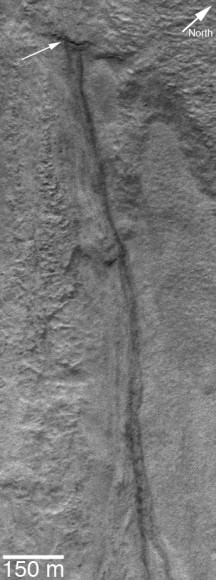[/caption]
In June 2000, Martian imaging scientists made a striking discovery — data from NASA’s Mars Global Surveyor spacecraft found gullies on the red planet. Gullies on Earth form when water runs down steep slopes and carves soil out of its way, so the discovery of this geologic feature on Mars was enticing evidence that liquid water existed on or near the surface of Mars.
But gullies have also been spotted in the Mars’ polar regions where the temperature is too cold for water to exist in its liquid form. Adding to the puzzle is the suggestion that the apparent gullies are actually formed by wind or underground gases causing sand and dust to roll down a steep hill and create what looks like a gully formed by Water. So what’s behind the gullies at Mars’ poles?

Frozen carbon dioxide — more commonly known as dry ice — isn’t an uncommon feature on Mars. It can freeze out of the carbon dioxide rich atmosphere on Mars and, after a dust storm, be covered by a thin layer of dust or sand. Recently, researchers are looking to this subsurface dry ice as a possible explanation for Martian gullies, particularly at the frozen poles.
The key here is sublimation — the phenomenon of a solid passing directly into its gaseous state. You’ve seen this happen if you’ve ever poured water on dry ice. The water warms the solid dry ice and turn it into a gas. On Mars, it’s possible that changes in temperatures with seasons could be enough to sublimate the frozen carbon dioxide. The expulsion of the gas through the soil on the surface could cause it to roll down a hill like a fluid. The same thing would happen with water coming up from under ground.
Whether or not dry ice sublimation is behind polar gullies became a focus of Yolanda Cedillo-Flores and three colleagues at the Lunar and Planetary Institute in Houston, Texas.
A previous study testing whether sublimating dry ice could form gullies, led by Cedillo-Flores, was brilliant in its simplicity. They piled sand into Mars-like slopes then blew air underneath the sand. The sand flowed down the slope, much like a liquid would, and formed was looked very much like a gully.
Recently, the team at the Lunar and Planetary Institute have been testing the possibility of this phenomenon happening on Mars. They used the average daytime and seasonal temperatures of the Martian year to calculate the sublimation rate of dry ice on Mars. Then, they ran models of this event on Martian areas without any sediment as well as those with layers of sand and dust of varying thickness over the average seasonal deposit of dry ice. When simulated spring came, enough heat reached the dry ice that it sublimated and acted like a fluid. Turns out, Mars is just right for seasonal sublimation of frozen carbon dioxide.
They finally came to the conclusion that carbon dioxide sublimation is the likeliest cause behind the gullies forming in Mars’ polar regions.
Sources: Martian gullies: Produced by fluidization of dry material, CO2 gas fluidization in the initiation and formation of Martian polar gullies.



The gullies imaged in 2001/2005 respectively – If you look in both images you see another one higher-right forming a kind of triangle with the small crater under it and the other gully.
My question is: Why was this one still at its same state, especially at such close distance (~600m) to its cousin?
Use more ice and your soda won’t loose it’s fizz as fast? How about… having naturally carbonated water ice cubes from Mars put in your drink at the bar? That’ll be the day… eh?
So gaseous liquefaction in Martian soils generates landslides and gullies…. bet the debris piles are fluffy! Swimming in dust anyone?
I KNOW I left my vacuum around here somewhere and just LOOK at all this DUST!